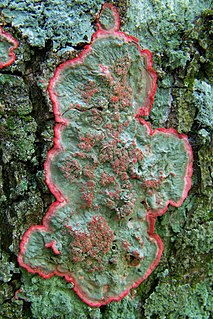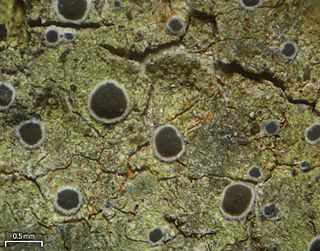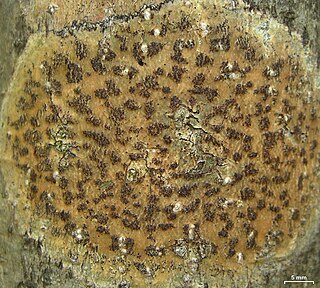
The Arthoniales is the second largest orders of mainly crustose lichens, but fruticose lichens are present as well. The order contains around 1500 species, while the largest order with lichenized fungi, the Lecanorales, contains more than 14000 species.

The Pilocarpaceae are a family of crustose lichens in the order Lecanorales. The species of this family have a cosmopolitan distribution and have been found in a variety of climatic regions. Pilocarpaceae was circumscribed by Alexander Zahlbruckner in Adolf Engler's influential 1905 work Die Natürlichen Pflanzenfamilien.
Xerotrema is a genus of two species of lichen in the family Odontotremataceae. The genus was circumscribed by Martha Allen Sherwood and Brian John Coppins in 1980. The type species, Xerotrema megalospora, is found in the United States and Canada. X. quercicola was added to the genus in 2008.
Mazaediothecium is a genus of calicioid lichens in the family Pyrenulaceae. It has four species. The genus was circumscribed by Dutch lichenologist André Aptroot in 1991, with Mazaediothecium rubiginosum assigned as the type species.
Lithothelium is a genus of lichen-forming fungi in the family Pyrenulaceae. Most of the species are found in tropical climates, and are usually corticolous (bark-dwelling) or saxicolous (rock-dwelling). The genus was circumscribed by Swiss botanist Johannes Müller Argoviensis in 1885.
Clypeopyrenis is a genus of lichen-forming fungi in the family Pyrenulaceae. The genus was circumscribed in 1991 by Dutch lichenologist André Aptroot, with Clypeopyrenis microsperma assigned as the type species. This lichen, originally described from material collected in Costa Rica, is also found in the Caribbean and South America. Clypeopyrenis porinoides was added to the genus in 2011; it was discovered in Costa Rica, close to the type locality of the type species.
Septotrapelia is a genus of lichen-forming fungi in the family Pilocarpaceae. It has four species. It was validly published as a genus in 2007 by lichenologists André Aptroot and Jose-Luis Chaves.

Lecanactis is a genus of crustose lichens, commonly called old wood rimmed lichen. The genus was circumscribed in 1855 by German lichenologist Gustav Wilhelm Körber, who assigned Lecanactis abietina as the type species.

Anisomeridium is a genus of lichens in the family Monoblastiaceae. The type species was originally named Arthopyrenia xylogena by Swiss botanist Johannes Müller Argoviensis in 1883; in 1928, Maurice Choisy defined the genus Anisomeridium, designating A. xylogena the type species.

Pyrrhospora is a genus of lichen-forming fungi in the family Lecanoraceae. The genus was circumscribed by German lichenologist Gustav Wilhelm Körber in 1855, with Pyrrhospora quernea assigned as the type species.
Traponora is a genus of lichen-forming fungi in the family Lecanoraceae. The genus was circumscribed in 2009 by Dutch lichenologist André Aptroot, with the Papua New Guinean Traponora asterella assigned as the type, and at that time, only species. Four newly described species were added to the genus in a 2009 publication, a species formerly in Pyrrhospora was transferred to the genus in 2017, and a new species from Australia added in 2018. Traponora lichens are predominantly from Australasia, with all species but one known to occur in Papua New Guinea.

Gyalidea is a genus of crustose lichens in the family Gomphillaceae. It has 50 species.

Architrypethelium is a genus of lichen-forming fungi in the family Trypetheliaceae. The genus was circumscribed in 1991 by Dutch lichenologist André Aptroot, with A. seminudum assigned as the type species. It is a segregate of genus Trypethelium.
Pseudopyrenula is a genus of lichen-forming fungi in the family Trypetheliaceae.
Sprucidea is a genus of four crustose lichens in the family Malmideaceae. Similar to the related genus Malmidea, Sprucidea is characterized by frequently red thalli that contain the secondary compound norsolorinic acid, but differs in the rod-shaped instead of ellipsoid ascospores and in the stalked sporodochia as conidiomata. Sprucidea species are found in rainforest areas in South America and Southeast Asia.

Strigulaceae is a family of lichen-forming fungi, one of two families in the order Strigulales. Recent (2020) molecular analysis of the type genus, Strigula, has led to a reallocation of the foliicolous species into six genera that correspond to well-delimited clades with diagnostic phenotype features.
Aquacidia is a genus of lichen-forming fungi in the family Pilocarpaceae. It has three species, which occur in Europe and North America. The genus was circumscribed in 2018 by André Aptroot to contain a small group of Bacidia species that formed a distinct lineage in the Pilocarpaceae. The type species is Aquacidia trachona, a lichen that was originally described in 1803 by Erik Acharius as Verrucaria trachona. The genus name Aquacidia refers to the habitat of the species, which is typically on rocks near water. Lichens in this genus can form thalli that cover vast areas of substrate. For example, in Holland, the lichens can form large colonies in sheltered rock crevices between boulders in dikes.

Roccellinastrum is a genus of lichen-forming fungi in the family Pilocarpaceae. It has seven species.

Viridothelium is a genus of lichen-forming fungi in the family Trypetheliaceae. It has 11 species. The genus was circumscribed by Robert Lücking, Matthew Nelsen, and André Aptroot in 2016, with Viridothelium virens assigned as the type species. Lichens in this genus were previously assigned to genus Trypethelium, as part of the Trypethelium virens clade.
Angiactis is a genus of crustose lichens of uncertain familial placement in the order Arthoniales. It has four species.









